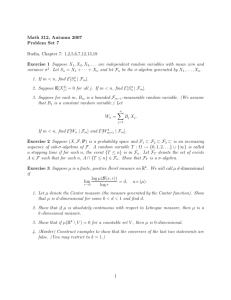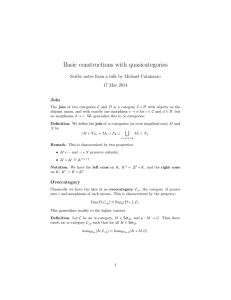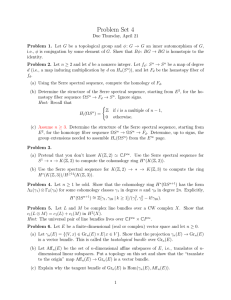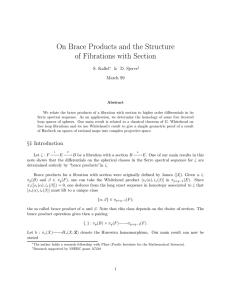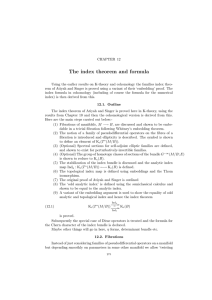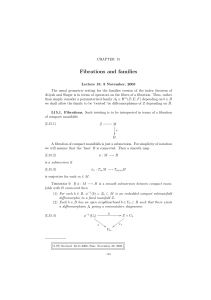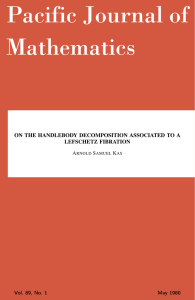Problem Set 3
advertisement
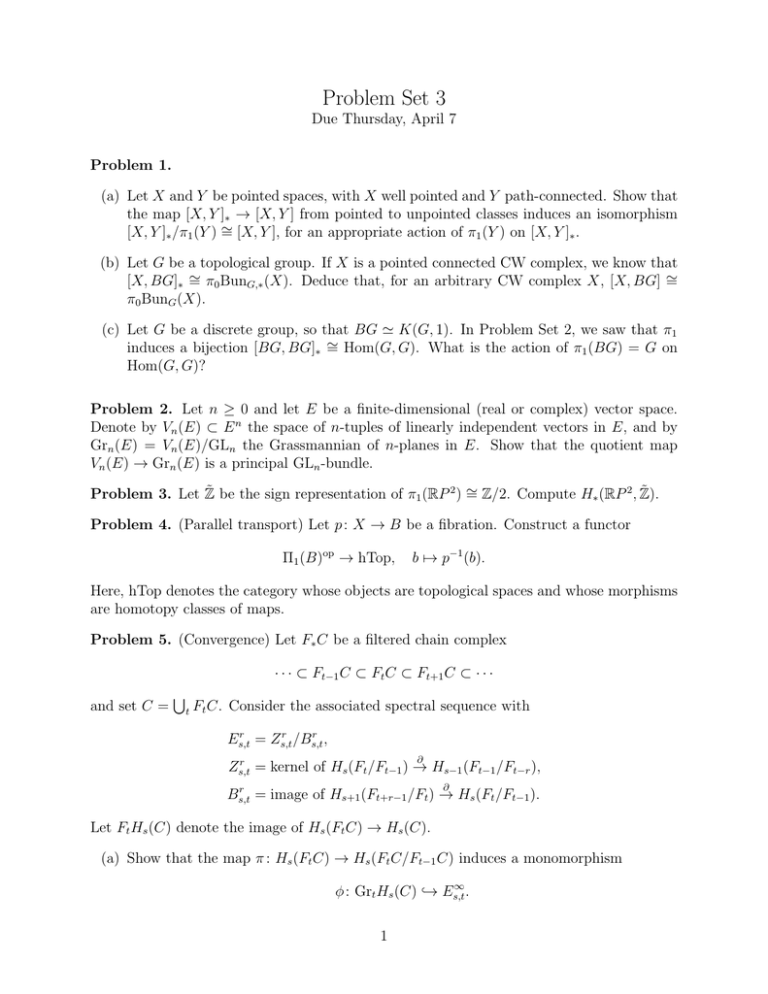
Problem Set 3 Due Thursday, April 7 Problem 1. (a) Let X and Y be pointed spaces, with X well pointed and Y path-connected. Show that the map [X, Y ]∗ → [X, Y ] from pointed to unpointed classes induces an isomorphism [X, Y ]∗ /π1 (Y ) ∼ = [X, Y ], for an appropriate action of π1 (Y ) on [X, Y ]∗ . (b) Let G be a topological group. If X is a pointed connected CW complex, we know that [X, BG]∗ ∼ = π0 BunG,∗ (X). Deduce that, for an arbitrary CW complex X, [X, BG] ∼ = π0 BunG (X). (c) Let G be a discrete group, so that BG ' K(G, 1). In Problem Set 2, we saw that π1 induces a bijection [BG, BG]∗ ∼ = Hom(G, G). What is the action of π1 (BG) = G on Hom(G, G)? Problem 2. Let n ≥ 0 and let E be a finite-dimensional (real or complex) vector space. Denote by Vn (E) ⊂ E n the space of n-tuples of linearly independent vectors in E, and by Grn (E) = Vn (E)/GLn the Grassmannian of n-planes in E. Show that the quotient map Vn (E) → Grn (E) is a principal GLn -bundle. Problem 3. Let Z̃ be the sign representation of π1 (RP 2 ) ∼ = Z/2. Compute H∗ (RP 2 , Z̃). Problem 4. (Parallel transport) Let p : X → B be a fibration. Construct a functor Π1 (B)op → hTop, b 7→ p−1 (b). Here, hTop denotes the category whose objects are topological spaces and whose morphisms are homotopy classes of maps. Problem 5. (Convergence) Let F∗ C be a filtered chain complex · · · ⊂ Ft−1 C ⊂ Ft C ⊂ Ft+1 C ⊂ · · · and set C = S t Ft C. Consider the associated spectral sequence with r r r Es,t = Zs,t /Bs,t , ∂ r Zs,t = kernel of Hs (Ft /Ft−1 ) → Hs−1 (Ft−1 /Ft−r ), ∂ r Bs,t = image of Hs+1 (Ft+r−1 /Ft ) → Hs (Ft /Ft−1 ). Let Ft Hs (C) denote the image of Hs (Ft C) → Hs (C). (a) Show that the map π : Hs (Ft C) → Hs (Ft C/Ft−1 C) induces a monomorphism ∞ φ : Grt Hs (C) ,→ Es,t . 1 (b) Suppose that, for every s, there exists t0 such that Hs (Ft C) = 0 for t ≤ t0 . Show that φ is an isomorphism. Problem 6. Compute all pages and differentials of the homological Serre spectral sequence for the Hopf fibration S 3 → S 2 . Problem 7. Let B be a CW complex and p : X → B a fibration. (a) Suppose that the fibers of p are connected. Show that the composition 2 ∼ ∞ ,→ Es,s Hs (X) Hs (X)/Fs−1 Hs (X) ∼ = Hs (B) = Es,s is p∗ : Hs (X) → Hs (B). (b) Suppose that B is simply connected and let i : F ,→ X be a chosen fiber of p. Show that the composition 2 ∞ ∼ Hs (F ) ∼ Es,0 = Es,0 = F0 Hs (X) ,→ Hs (X) is i∗ : Hs (F ) → Hs (X). Problem 8. SLet F∗ C be a filtered chain complex satisfying the assumption of Problem 5 (b), let C = t Ft C, and let n ≥ 1. Suppose that the E n page is everywhere zero, except on two parallel lines of finite integral slope e < n in the (s, t)-plane, separated vertically by n − e units. Draw a picture of the situation and note that the differential dn maps the upper line to the lower line. This happens for example if the filtration F∗ C only jumps twice, in which case e = 0 and n is the distance between the jumps. (a) Construct a long exact sequence of the form d n n n · · · → Hs+1 (C) → Es+1,f → Es,f (s)+n − (s) → Hs (C) → · · · , where t = f (s) is the equation of the lower line. In the rest of this problem, we look at two special cases of this phenomenon to be found in the Serre spectral sequence. Let p : X → B be a fibration with chosen fiber i : F ,→ X. (b) Suppose that B ' S n for some n ≥ 2. Construct a long exact sequence i ∗ · · · → Hs+1 (X) → Hs+1−n (F ) → Hs (F ) − → Hs (X) → · · · . This is called the Wang sequence. (c) Suppose that F ' S n for some n ≥ 1 and that B is simply connected. Construct a long exact sequence p∗ · · · → Hs+1 (X) − → Hs+1 (B) → Hs−n (B) → Hs (X) → · · · . This is called the Gysin sequence. (d) Optional. What changes in (b) when n = 1 and in (c) when B is not simply connected? 2





